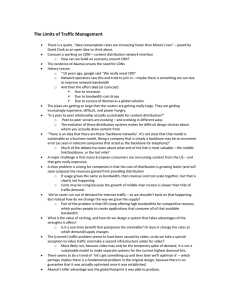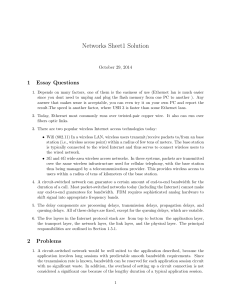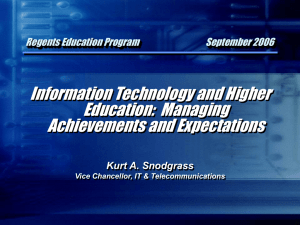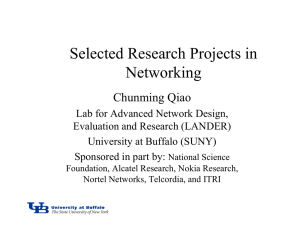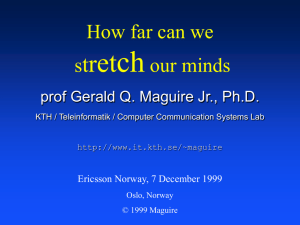CSC 322 Final Summary
advertisement
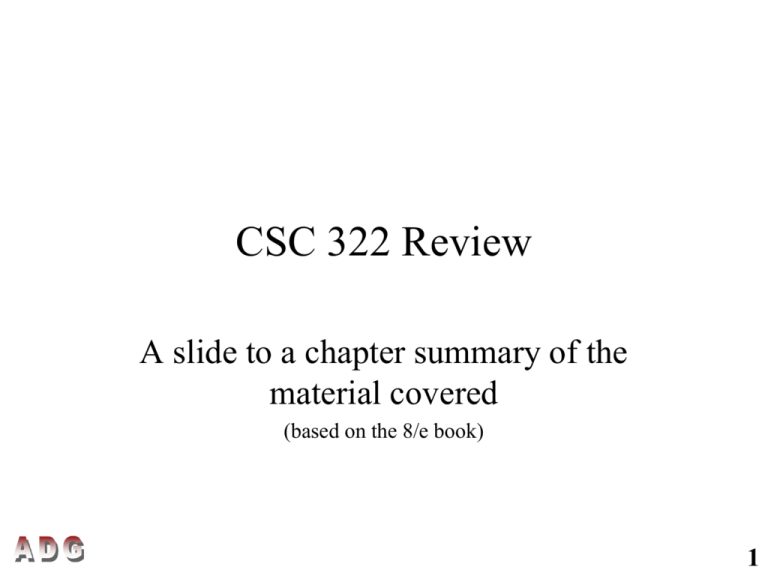
CSC 322 Review A slide to a chapter summary of the material covered (based on the 8/e book) 1 C1. Data Communications and Networking Overview • The 3 (or 5) entity general communication model • Actual data communications is more complicated – Transmission system utilization, interface, signal generation, synchronization, exchange management, error detection and correction, flow control, addressing, routing, recovery, message formatting, security, network management • Networking – LANs (one organisation, smaller area, faster speeds) – WANs (larger areas, crossing public rights of way, common carrier circuits) • circuit switching, • packet switching – frame relay, cell relay (ATM) – MANs (middle ground) 2 C2. Protocol Architecture • A simple (quite general) protocol architecture – Protocols: syntax, timing, semantics • Layering combats complexity – Peer layered architecture – Information flow (down across up) • Open System Interconnection (OSI) – 7 layers – Standardisation framework – Service Primitives, and Parameters • The TCP/IP protocol architecture – 5 layers – The “industry/world” standard 3 C3. Data transmission • Terminology – Frequency, spectrum, bandwidth, effective bandwidth, etc • Any signal can be expressed as an infinite number of sine waves (frequency components). – Remember it is only the odd ones (f, 3f, 5f, 7f….) • Relationship between data rate and bandwidth – The higher the data rate the higher the required bandwidth – The higher the bandwidth the greater data rate can be achieved • Transmission impairments – attenuation, delay distortion, noise (4 types) • Channel capacity – Nyquist (error & noise free, f(B, channels)) – Shannon (error free, f(B, SNR)) 4 C4. Transmission Media • Guided media – Twisted pair (2 versions), coaxial, optical fibre – Description, characteristics, categories • Wireless transmission technologies – Dish antenna, Antenna gain – Microwave (earth & satellite), broadcast radio, infrared • Wireless propagation – Skywave, line-of-sight, groundwave • Wireless (line-of-sight) impairments – Free space loss, refraction, atmospheric absorption, mutlipath 5 C5. Signal Encoding Techniques • Digital(=D) & Analogue(=A) Data – to Digital & Analogue Signals • D-data A-signal – Frequency/Phase/Amplitude shift keying • D-data D-signal – NRZ, Multilevel, Biphase – Scrambling • A-data D-signal – Delta, Pulse code • A-data A-signal(3) – AM, FM 6 C6. Digital Data Communication Techniques • Transmission approaches – Synchronous – Asynchronous • Errors, types – Single bit, Burst errors • Error detection – Check bits • Error correction – FEC, Redudancy, hamming distance 7 C7. Data Link Control Protocols • Flow control (S&W, SW) • Error control – 4 Mechanisms of ARQ – 3 version of ARQ • HDLC protocol – Basics • types of stations (3) • Configuration (2) • modes (3) – Frame types and structure (I / S / U) – Operation (3 phase type) 8 C8. Multiplexing • Utilising a single line to relay multiple connections • Frequency Division MUXing • Time Division MUXing – MUXed line has at least the data rate of the sum of lines – Slots are fixed and allocated • Statistical Time Division (relies on non frequent use) – Slots are allocated on demand – MUXed line has less than the sum of lines being MUXed • ADSL – Separates the 1MHz in 3 regions (POTS, Upstream, Downstream) – FDM within upload and download 9 C14. Cellular Wireless Networks • Not covered fully (first 14 slides) • Cellular network organisation – Cells – Frequency reuse – Increasing the capacity • Operation of a cellular systems – Base station – Cells – MTSO 10 C17. Wireless Networks • Single and multi cell LANs • Applications (nomadic, adhoc, cross building, lan extension) • Technologies (just the names) – IR, Spread spectrum, Narrow band microwave 11 C15. LAN Overview • LAN applications (high speed, backbone, storage area networks, personal, backend) • Topologies (ring, star, bus, tree) • IEEE 802 reference model – LLC and MAC • Medium Acces Control – Central vs distributed – Synchronous vs asynchronous • Asynhronous – Round robin, reservation, contention • Bridges, Switches, Hub, Layer 2 & 3 (hardware switches) 12
